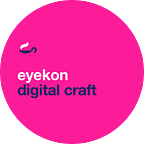The Doors Are Open: Accessibility is a Key to the Digital Customer Experience
User first: The customer experience is the be-all and end-all of a digital service. With the Eyekon accessibility checklist you can identify and improve accessibility in the UX/UI design of your digital service. A customer experience that pays attention to accessibility clearly stands out from the competition.
Written by Daniel Holler
User Frustration
Can you relate? You’re looking for a specific product in an online store, but you’re having trouble reading the description — somehow the text doesn’t stand out enough from the background. Also, what happens if you click on this button without a label? These are typical examples of poor usability (user-friendliness) — and often also signs of a lack of accessibility in UX / UI design. What follows is frustration for users. And frustration can be fatal for a business in the fast-moving digital world — namely when users leave and go look for an accessible alternative from the competition.
Accessibility vs. Usability
What exactly is the difference between usability and accessibility?
Both revolve around the accessibility of a digital product: While usability relates to the overall experience, accessibility mainly describes the access for people with disabilities — good accessibility means that all users, including those with disabilities, encounter an equal customer experience.
This has two advantages. First off, all users benefit from a flexible, human-centered customer experience that works flawlessly in a wide variety of situations and environments. User flows are streamlined, leading to quick conversions. Second, people with disabilities, who make up one fifth of the population in Europe and thus have significant, often underestimated purchasing power, can easily use a digital service.
Users Who Benefit From Accessibility
The purchasing power that can be tapped through good accessibility is often underestimated. But why is that? Users with restrictions include not only people with irreversible disabilities, but also those with temporary or environmental restrictions. For example, if someone:
- has a “temporary impairment”, such as a broken arm, or even lost glasses.
- is in unfavorable surroundings with glaring light or noise.
- is in a remote location with slow and unreliable internet connection.
- has age-related restrictions (poor eyesight, poor hearing, declining fine motor skills).
- uses small, outdated or unwieldy devices (smartwatch, smart TV, etc.).
The possibilities that accessibility offers for a better and more efficient customer experience are all too often underestimated. Accessibility implemented at all levels helps far more than just people who normally have difficulties using a digital product. These simple measures affect and improve all areas of a digital service, from conception to implementation.
Where Should Accessibility be Considered in a Digital Product?
It is worthwhile to address accessibility early in the conception, as the relevant disciplines build on one another:
- Accessibility in the design process
Accessibility begins with the first steps in the development of a digital product. There are simple approaches that can be integrated into the work process: User research should also include people outside of the usual demographic groups, such as users with restrictions and users from various countries and cultures. In order to be able to design for accessibility, you first have to get to know and understand the users. - Accessibility in the code
Even in the technical development (frontend) it is worth paying attention to accessibility guidelines. People with visual impairments often use keyboard navigation, which is made possible by focus states of the individual elements in a website. It is also important to use semantic HTML (HTML tags that have predefined functions and can be read automatically by auxiliary software and search engines). It is also important to use clean alt tags on images so that they can be understood by people with visual impairments. All of this even has positive side effects: Better search results through search engine optimization (SEO) and faster loading times. - Accessibility in content and design
There is no question that digital accessibility is primarily evident in the content and structure. Not just high-contrast text, but also the structure, hierarchy and designation of elements of the website or app. It is worth paying attention to reading direction, text (expression) and the presentation of information: Does it need color, icons and visual cues? The devil is in the details — our accessibility guidelines can support you if you happen to speak German :).
These guidelines raise overall usability to a higher level. They not only help people with disabilities to navigate unhindered through a digital product, but also optimize the user experience for all. The resulting customer experience is more holistic because nothing is left to chance. In addition, every function and every touchpoint is designed with diverse users in mind and therefore covers many situations and scenarios. This in turn means that you have more precise control over the customer experience, and thus reach more users in a sustainable way.
A Customer Experience for Everyone: Win-Win
The holistic integration of accessibility into a digital product is a win-win situation for users and companies. The user experience and the company benefit from “hard numbers”, such as increased traffic thanks to search engine optimization (SEO). More traffic also arises from the simple fact that a higher number of users can be reached: There are more ways and better possibilities to access a digital product on different devices (and in different environments). It also creates a smoother, uninterrupted customer journey, which increases the likelihood of conversions.
Accessibility measures also open up sustainable access to growing and underrepresented population groups. You benefit from the as yet untapped purchasing power of, for example, people of retirement age. On top of that, barrier-free design also plays a very important role in the image of a company. Today, a company’s image is a very important decision factor for the choice of product or shop, especially among young people.
